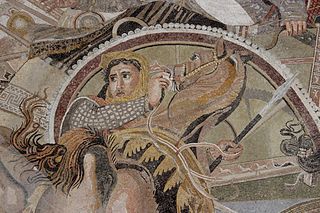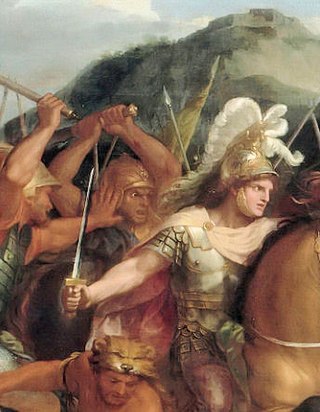
Darius III was the last Achaemenid King of Kings of Persia, reigning from 336 BC to his death in 330 BC.

Antigonus I Monophthalmus was a Macedonian Greek general and successor of Alexander the Great. A prominent military leader in Alexander's army, he went on to control large parts of Alexander's former empire. He assumed the title of basileus (king) in 306 BC and reigned until his death. He was the founder of the Antigonid dynasty, which ruled over Macedonia until its conquest by the Roman Republic in 168 BC.

The Battle of Issus occurred in southern Anatolia, on 5 November 333 BC between the Hellenic League led by Alexander the Great and the Achaemenid Empire, led by Darius III. It was the second great battle of Alexander's conquest of Asia, and the first encounter between Darius III and Alexander the Great. The battle resulted in the Macedonian troops defeating the Persian forces.

The Battle of Gaugamela, also called the Battle of Arbela, took place in 331 BC between the forces of the Army of Macedon under Alexander the Great and the Persian Army under King Darius III. It was the second and final battle between the two kings, and is considered to be the final blow to the Achaemenid Empire, resulting in its complete conquest by Alexander.

The Battle of the Granicus in May 334 BC was the first of three major battles fought between Alexander the Great of Macedon and the Persian Achaemenid Empire. The battle took place on the road from Abydus to Dascylium, at the crossing of the Granicus in the Troad region, which is now called the Biga River in Turkey. In the battle Alexander defeated the field army of the Persian satraps of Asia Minor, which defended the river crossing. After this battle, the Persians were forced on the defensive in the cities that remained under their control in the region.

Oxyathres was a brother of the Persian king Darius III Codomannus. He was the son of a certain Arsames, and grandson of Ostanes. He was distinguished for his bravery and talent, and in the battle of Issus, 333 BC, took a prominent part in the combat in defence of the king, when attacked by the Macedonian cavalry under Alexander himself, as shown in the celebrated Alexander Mosaic found in Pompeii. He afterwards accompanied Darius on his flight into Bactria, and fell into the hands of Alexander during the pursuit, but was treated with the utmost distinction by the conqueror, who even assigned him an honourable post about his own person; and subsequently devolved upon him the task of punishing Bessus for the murder of Darius. He was also the father of Amastris queen of Heraclea.

Balakros, also Balacrus, the son of Nicanor, one of Alexander the Great's "Somatophylakes" (bodyguards), was appointed satrap of Cilicia after the Battle of Issus, 333 BC. He succeeded to the last Achaemenid satrap of Cilicia, Arsames.

Spithridates was a Persian satrap of Lydia and Ionia under the high king Darius III Codomannus. He was one of the Persian commanders at the Battle of the Granicus, in 334 BC. In this engagement, while he was aiming a blow from behind at Alexander the Great, his arm was cut off by Cleitus the Black and he subsequently died.
Amyntas was a Macedonian officer in Alexander the Great's army, son of Andromenes from Tymphaia. After the Battle of the Granicus, 334 BC, when the garrison of Sardis was quietly surrendered to Alexander, Amyntas was the officer sent forward to receive it from the commander, Mithrenes. Two years after, 332, we again hear of him as being sent into Macedonia to collect levies, while Alexander after the siege of Gaza advanced to Egypt; and he returned with them in the ensuing year, when the king was in possession of Susa.
Mithrenes was a Persian commander of the force that garrisoned the citadel of Sardis. According to Cyril Toumanoff, he was also a member of the Orontid dynasty, of Iranian origin. Waldemar Heckel, on the other hand, considers Mithrenes to be a Persian noble of unknown family background. After the battle of the Granicus Mithrenes surrendered voluntarily to Alexander the Great, and was treated by him with great distinction. Mithrenes was present in the Macedonian camp after the Battle of Issus, and Alexander ordered him to visit the captured family of Darius III and assure them that Darius was alive, before changing his mind and assigning the duty to Leonnatus instead. He fought for Alexander at Gaugamela, and ironically he was fighting against an army that included his father Orontes II. Afterwards, Alexander appointed him Satrap of Armenia.

Satibarzanes, a Persian, was satrap of Aria under Darius III, king of Persia.
Nicanor, son of Parmenion, was a distinguished officer in the service of Alexander the Great. He is first mentioned at the passage of the Danube river, in the expedition of Alexander against the Getae, 335, when he led the phalanx. But during the expedition into Asia he appears to have uniformly held the chief command of the body of troops called the Hypaspists (υπασπισται) shield-bearers or foot-guards, numbering three units of 1,000 men. As his brother Philotas did that of the εταιρoι, or horse-guards. We find him mentioned, as holding this post, in the three great battles of the Granicus, of Issus, and of Gaugamela. He afterwards accompanied Alexander with a part of the troops under his command, during the rapid march of the king in pursuit of the king Darius III Codomannus in 330; which was probably his last service, as he died of disease shortly afterwards, during the advance of Alexander into Bactria. His death at this juncture was considered a fortunate event, as it prevented him from participating either in the designs or the fate of his brother Philotas.

Neoptolemus was a Macedonian officer who served under Alexander the Great.
The Battle of Megalopolis was fought in 331 BC between Spartan-led forces and Macedonia. Alexander's regent Antipater led the Macedonians to victory over King Agis III. Alexander, warring in Asia at the time, called it a "battle of mice", according to Plutarch.

Pharnabazus III was a Persian satrap who fought against Alexander the Great. His father was Artabazos II, and his mother a Greek from Rhodes.

Orontes II was a Persian noble living in the 4th century BC. He is probably to be identified as the satrap of Armenia under Darius III, and may in fact have succeeded Darius in this position when Darius ascended the throne of Persia in 336 BC.
Rheomithres was a Persian noble. He was father of several children, including Phrasaortes whom Alexander the Great appointed satrap of Persis in 330 BC. He joined in the Great Satraps' Revolt of the western Persian provinces from Artaxerxes II, in 362 BC, and was employed by his confederates to go to Tachos, pharaoh of Egypt, for aid. He came back with 500 talents and 50 warships and he is supposed to have left his wife and his children to Tachos as a guarantee for his assistance. Nevertheless, Rheomithres betrayed the rebels and he invited a number of them in a meeting. On their arrival, he arrested them, and despatched them in chains to Artaxerxes to receive the bounties, thus making his own peace at court. Rheomithres took part in the battle of the Granicus, in 334 BC, where he was in command of a body of 2,000 cavalry on the right wing, between 1,000 Medes and 2,000 Bactrians. He survived the battle and the next year he joined Darius at the battle of Issus, where he lost his life.
Atizyes was a Persian satrap of Greater Phrygia under the Achaemenids in 334 BC, when Alexander the Great began his campaign. He is not mentioned in the council of Zelea where the satrap coalition was formed against the invasion, so it is not sure whether he took part in the battle of the Granicus. After the battle, he appears to be in the capital of Greater Phrygia, Celaenae where he had a garrison force of 1,000 Carians and 100 Greek mercenaries. He himself went to Syria to join the army of Darius III and fell in the battle of Issus at 333 BC. After Phrygia fell to Alexander, he appointed his general Antigonus Monophthalmus as its satrap.

Pherendates II was an Achaemenid satrap of ancient Egypt during the 4th century BCE, at the time of the 31st Dynasty of Egypt.

Mazaces, also Mazakes, was the last Achaemenid satrap of ancient Egypt during the late reign of Darius III of the 31st Dynasty of Egypt.

















